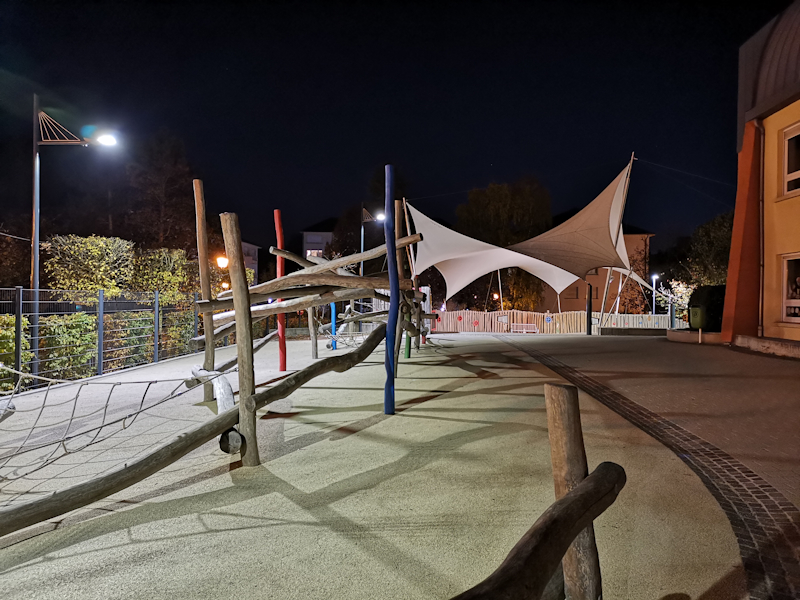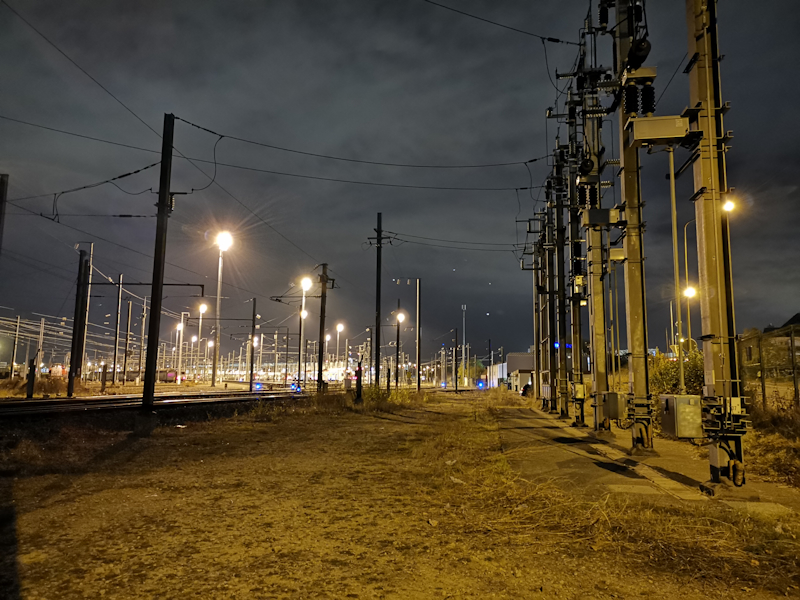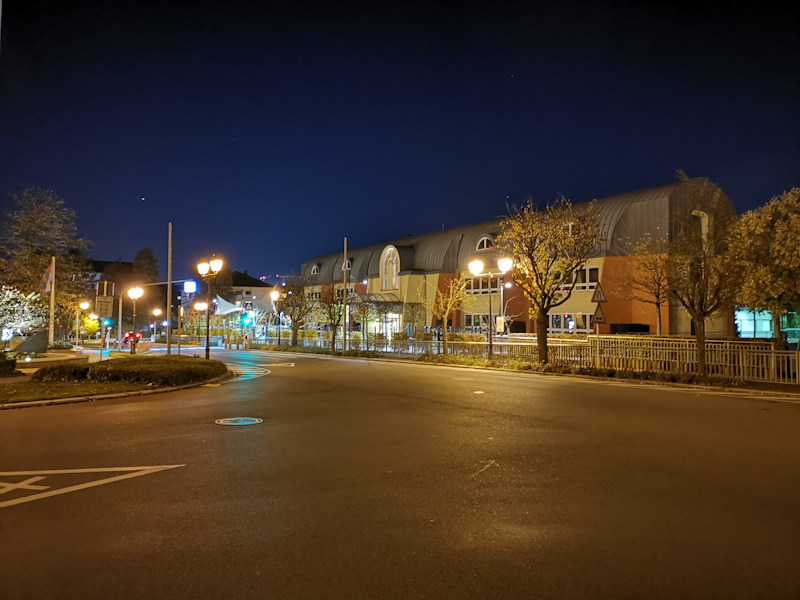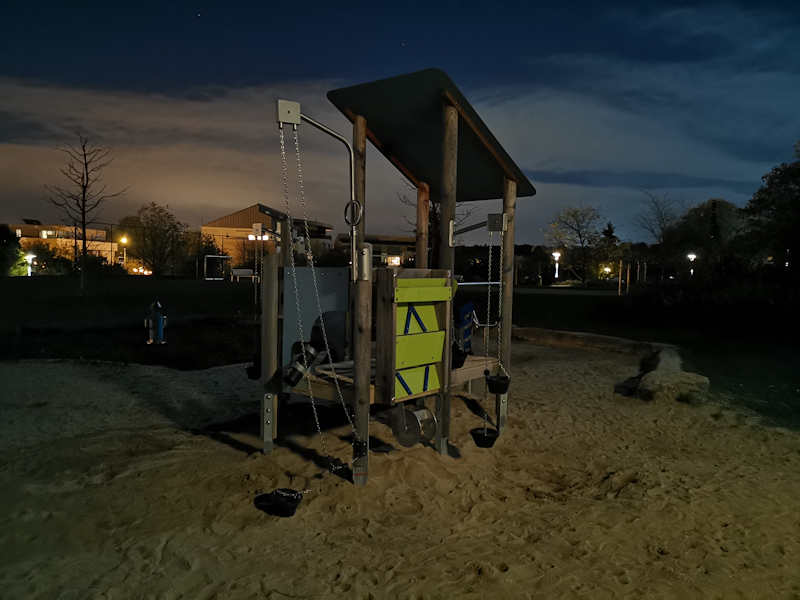The Mate 20 & Mate 20 Pro Review: Kirin 980 Powering Two Contrasting Devices
by Andrei Frumusanu on November 16, 2018 8:10 AM EST- Posted in
- Smartphones
- Huawei
- Mobile
- Kirin 980
- Mate 20
- Mate 20 Pro
Camera - Low Light Evaluation - Night Sight
Low-light capture was a forte for Huawei this year, as they were the first to introduce a low-light mode that was able to capture vastly superior exposure shots without having to use a tripod. The results on the P20’s were excellent, so let’s see how the new Mate 20’s fare.
[ Mate 20Pro ] - [ Mate 20 ] - [ P20Pro ]
[ P20 ] - [ Mate 10Pro ] - [ Pixel 3 ] - [ Pixel 2 ]
[ Pixel XL ] - [ iPhone XS ] - [ iPhone X ] - [ Note9 ] - [ S9+ ] - [ S8 ]
[ LG G7 ] - [ LG V30 ] - [ OnePlus 6 ] - [ OPPO FindX ] - [ MIX2S ]
In the first scene, the Mate 20 Pro goes off to a bad start as noted focus issues when capturing the scene. Here the phone multiple times took out of focus captures, with none of my night mode shots actually ending up in focus. In the regular mode, the Mate 20 Pro’s camera switches over to its unique high ISO mode and is able to deliver great results at ISO25600. We have to remember that the phones don’t actually have OIS, so again like on the P20 Pro this is quite remarkable. Also a big change compared to the P20 Pro is the colour rendition, here the Mate 20 Pro is able to extract much better colours out of the scene, and all while reducing noise significantly.
The Mate 20’s regular mode isn’t all that impressive as pretty much in line with how most sensors behave in low light. Here turning on Night mode is a requirement, and greatly improves the picture quality.
Google’s new Night Sight mode outmatches Huawei’s phones in terms of light capture, noise and detail retention, however the images is so bright that it’s less natural than the Mate’s results.
[ Mate 20Pro ] - [ Mate 20 ] - [ P20Pro ] - [ P20 ]
[ Mate 10Pro ] - [ Pixel 3 ] - [ Pixel 2 ] - [ Pixel XL ]
[ iPhone XS ] - [ iPhone X ] - [ Note9 ] - [ S9+ ] - [ S8 ]
[ LG G7 ] - [ LG V30 ] - [ OnePlus 6 ] - [ OPPO FindX ] - [ MIX2S ]
The second scene the Mate 20 Pro does a very different exposure to the P20 Pro, the latter did a much more accurate representation of the brightness and colour temperature of the sodium street lamps. Turning on night mode improved things a lot for both phones.
Overall the Mate 20’s are among the best low light shooters thanks to night mode, only recently dethroned by Google’s Pixel phones.
[ Mate 20Pro ] - [ Mate 20 ] - [ P20 ]
[ Mate 10Pro ] - [ Pixel 3 ] - [ Pixel 2 ] - [ Pixel XL ]
[ iPhone XS ] - [ iPhone X ] - [ Note9 ] [ S9+ ] - [ S8 ]
[ LG V30 ] - [ OnePlus 6 ] - [ OPPO FindX ]
The next scene the Mate 20 Pro varies in its results while in auto mode. The first shot has better dynamic range and also better detail retention, here Huawei needs a way to keep things more consistent. The regular mode on the Mate 20 is also good, although it’s lacking in texture detail as well showing some very weird blur in the right part of the image. Here I think the lack of OIS is hampering the phones.
Turning on night mode again improves the quality, but again the regular Mate 20 is giving out some blurred results here as its multi-frame stacking doesn’t seem to work correctly.
I would say the Mate 20 Pro along with the Pixel’s Night Sight modes are leading closely together.
[ Mate 20Pro ] - [ Mate 20 ] - [ P20Pro ] - [ P20 ]
[ Mate 10Pro ] - [ Pixel 3 ] - [ Pixel 2 ] - [ Pixel XL ]
[ iPhone XS ] - [ iPhone X ] - [ Note9 ] - [ S9+ ] - [ S8 ]
[ LG G7 ] - [ LG V30 ] - [ OnePlus 6 ] - [ OPPO FindX ] - [ MIX2S ]
Partial blurriness is again an issue of the Mate 20 in this scene. The Mate 20 Pro doesn’t have any issue in this regard, and captures the best regular mode shot among all phones.
Switching to night mode, it brightens up things for both units, and also resolves the blurriness issue on the Mate 20. Although Huawei’s phones are showcasing more realistic exposures, the Pixel phones night mode outclass them in terms of detail retention.
[ Mate 20Pro ] - [ Mate 20 ] - [ P20Pro ] - [ P20 ]
[ Mate 10Pro ] - [ Pixel 3 ] - [ Pixel 2 ] - [ Pixel XL ]
[ iPhone XS ] - [ iPhone X ] - [ Note9 ] - [ S9+ ] - [ S8 ]
[ LG G7 ] - [ LG V30 ] - [ OnePlus 6 ] - [ OPPO FindX ] - [ MIX2S ]
This scene again showcases some big blur issues on the regular Mate 20’s auto shots that are only resolved by turning on night mode. The Mate 20 Pro’s auto mode here produces the most natural result out of all phones.
In night mode, things brighten up a bunch, and Huawei manages much better results than other devices, but is yet again beat by Google’s new software.
Extreme low-light
Extreme low light scenarios is something as early as last year we wouldn’t have expected phones to be viable in. Again I started shooting such scenes earlier in the year when Huawei made its Night mode usable without a tripod – along with vendors like LG introducing pixel binning modes that quadruple the light capture of the sensors.
[ Mate 20Pro ] - [ Mate 20 ] - [ P20Pro ] - [ P20 ]
[ Mate 10Pro ] - [ Pixel 3 ] - [ Pixel 2 ] - [ Pixel XL ]
[ iPhone XS ] - [ iPhone X ] [ Note9 ] - [ S9+ ] - [ S8 ]
[ LG G7 ] - [ LG V30 ] - [ OnePlus 6 ] - [ OPPO FindX ] - [ MIX2S ]
In extreme low light scenarios, the Huawei phones were in a league of their own until just very recently. The Mate 20 Pro in its regular mode relies on ISO25600 to achieve a very good shot, beating all other phones including the P20Pro. The Mate 20 doesn’t fare as well here as its sensor just can’t capture enough light.
In night mode, the Mate 20 Pro gains in sharpness and sheds some of the noise, and the Mate 20 now manages to sufficiently light up the scene, although sharpness and detail aren’t too good. Although the Huawei again have a better natural reproduction of the light in the scene, Google’s night sight just produces a just ridiculously brighter scene that offers significantly better details.
[ Mate 20Pro ] - [ Mate 20 ] - [ P20Pro ] - [ Mate 10Pro ]
[ Pixel 3 ] - [ Pixel 2 ] - [ Pixel XL ]
[ iPhone XS ] - [ iPhone X ] - [ Note9 ] - [ S9+ ] - [ S8 ]
[ LG G7 ] - [ LG V30 ] - [ OnePlus 6 ] - [ OPPO FindX ] - [ MIX2S ]
Finally, in the darkest possible conditions, in a path under the light of the moon, the Mate 20 Pro and P20 Pro are the only camera sensors able to capture anything, with the Mate 20 Pro using its maximum ISO102400 mode. The Mate 20 largely remains blind. Night mode on the Mate 20 Pro actually regresses things in these conditions, while on the Mate 20 it allows to finally make out some parts of the scene.
Again both phones are beat by Google’s new night sight, achieving some pretty astounding results.
Low-light conclusion
Overall in low light conditions, the Mate 20 Pro is a clear leader in terms of its hardware capabilities. Just like on the P20 Pro, the massive sensor as well as is high ISO capabilities prove very beneficial for the phone.
The Mate 20 fared less well in regular mode, and underperforms most other flagships. Here the use of night mode is a requirement to get better shots out of the phone.
Up until recently this would have been the end of my conclusion, but the recent introduction of Google’s new night sight mode means that Huawei no longer is the best in low-light conditions. While I do feel that Google is overdoing it a bit and Huawei still produces the more realistic and representative exposures, the Pixel phones just have a tremendous detail and noise reduction advantage. Still, this is not to take away from Huawei’s great low-light performances, as it still stands above that of many other devices.

















141 Comments
View All Comments
Javert89 - Friday, November 16, 2018 - link
Perhaps the most interesting part is missing :( how is working (performance and power) the middle cluster at 1.92 ghz? Same performance of 2.8ghz A75 at half power usage?Andrei Frumusanu - Friday, November 16, 2018 - link
I couldn't test it without root.ternnence - Friday, November 16, 2018 - link
try syscall(__NR_sched_setaffinity, pid, sizeof(mask), &mask)ternnence - Friday, November 16, 2018 - link
FYI,https://stackoverflow.com/questions/7467848/is-it-...pjcamp - Friday, November 16, 2018 - link
If it weren't for Huawei's aggressively belligerent stance against unlocked bootloaders . . . .name99 - Friday, November 16, 2018 - link
Andrei, can you please explain something that I just do not understand in any of these phone reviews (Apple or Android).The die shots always show 4x 16-wide LPDDR4 PHYs. OK, so 64-bit wide channel to DRAM, seems reasonable.
Now the fastest normal LPDDR4 is LPDDr4-2133, which in any normal naming scheme would imply 2,133MT/s. So one transaction, 8 bytes wide, gives us guaranteed-not-to-exceed of 17GB/s.
But of course Huawei's Geekbench4 memory bandwidth is ~22GB/s. Maybe Huawei are using slightly faster LPDDr4-2166 or whatever, but the details don't change --- the only way the numbers work out is if the "maximum bandwidth" of the DRAM is actually around 34 GB/s.
Which implies that EITHER
- LPDDR4-2133 does NOT mean 2133MT/sec. (But that's what common sense would suggest, and this recent AnandTech article on DDR5
https://www.anandtech.com/show/13605/sk-hynix-deve... )
OR
- somehow there is 128-bits of width between all the high-end phone SoCs (either 2 independent 64-bit channels [more likely IMHO] or a single 128-bit wide channel).
Can you clarify?
anonomouse - Friday, November 16, 2018 - link
It’s 2133MHz IO and it’s DDR, so 4266MT/s. Each LPDDR4 channel is 16 bits. Hence the common listing of LPDDR4X-4266.Usually these are advertised/listed at the MT/s rate so DDR4-2666 has an IO clock of 1333MHz. Main difference being that DDR4 has a 64 bit channel width.
name99 - Friday, November 16, 2018 - link
But then look at the article I gave, for DDR5https://www.anandtech.com/show/13605/sk-hynix-deve...
This includes sentences like "The new DDR5 chip from SK Hynix supports a 5200 MT/sec/pin data transfer rate, which is 60% faster than the 3200 MT/s rate officially supported by DDR4."
which strongly implies that a DDR4-3200 is NOT running at 6400 MT/s.
WTF is going on here? Micron lists their LPDDR4, for example, as LPDDR4-2133, NOT as LPDDR4-4266?
N Zaljov - Sunday, November 18, 2018 - link
I fail to see any issues with the current naming convention, apart from being confusing asf."Micron lists their LPDDR4, for example, as LPDDR4-2133, NOT as LPDDR4-4266" - of course they are: https://www.micron.com/parts/dram/mobile-ddr4-sdra...
Although there seems to be a typo in the specs of their partlists, which can be confusing, but they are clearly listing their LPDDR4(x) as LPDDR4-4266 (or, typoed, LPDDR4-4166), with an I/O clk of 2133 MHz and an actual memory clockspeed of around 533,3 MHz (on-demand modulation will keep the clock of the memory arrays somewhere between 533,25 and 533,35, depending on the load).
Andrei Frumusanu - Friday, November 16, 2018 - link
The DSU's interface is limited at 2x 128bit per ACE interface to the memory subsystem/interconnect (32B/cycle in each direction) times the frequency of the DSU/L3 of which we aren't certain in the Kirin 980, but let's take the S845 which runs at 1478MHz IIRC: ~47GB/s. Plenty enough. We don't know the interconnect bandwidth from the DSU to the memory controller. The memory controllers themselves internally run at a different frequency (usually half) but what matters is talking about the DRAM speed. The Kirin 980/Mate 20's run on LPDDR4X at 2133MHz, or actually 4266MT/s because it's DDR. That's a peak of 4*16*4266/8=34.12GB/s.The actual answer is a lot simpler and more stupid. Geekbench 4's multi-threaded memory test just caps out at 2 threads, so in reality there's only ever two CPUs stressing the memory controller. Beyond this I've been told by some vendors that it doesn't scale in the test itself.
My conclusion: Ignore all the GB4 memory tests.